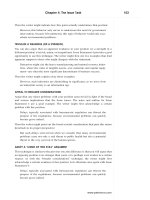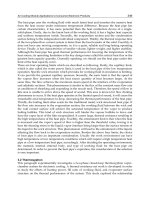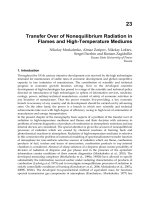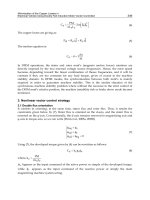Polyme Analysis 2010 Part 13 pdf
Bạn đang xem bản rút gọn của tài liệu. Xem và tải ngay bản đầy đủ của tài liệu tại đây (141.65 KB, 6 trang )
Double Bonds
FTIR
Bending Vibrations
Single Bonds (not to Hydrogen)
Triple Bonds
['naitrail]
FTIR
-The aromatic ring, (C6H5):
+ the group of bands (C-H) above 3010
+a distinctive C=C stretch at about 1600cm-1
-The saturated main chain CH groups: the bands below 3010
C C
H
H H
n
Transmission
FTIR of polystyrene
I
s
, I
R
: intensities in the sample and reference beams
-Sample preparation dependent on the physical form of the sample to be analysed.
1. Solids
-Nujolmull
-Potassium bromide disks
-Preparing a solution in a suitable solvent
*NujolMull
-The sample is ground to give a very fine powder
-A small amount is then mixed with nujol → a paste
-Several drops of this paste are then applied between two sodium chloride plates
-The plates are then placed in the instrument sample holder readyfor scanning.
Sample Preparation
FTIR
*Potassium Bromide disk
-A very small amount of the solid (approximately 1-2 mg) is added to pure
potassium bromide powder (KBr, ∼200 mg) and ground up as fine as possible.
-This is then placed in a small die and put under pressure mechanically (several
minutes)
-Removing the die and the KBrdisk formed. The disk is then placed in a sample
holder ready for scanning.
Sample Preparation
FTIR
2. Liquids
-The simplest and most common method of sample preparation.
-A drop of the sample is placed between two potassium bromide or sodium chloride
circular plates to produce a thin film.
-The plates are then placed in a holder ready for analysis.
3. Thin Films
-Placing a sample in a suitable holder, such as a card with a slot cut for the
sample window.
Sample Preparation
FTIR









